Last updated: January 8, 2025
Article
Charlestown Navy Yard: Marine Barracks
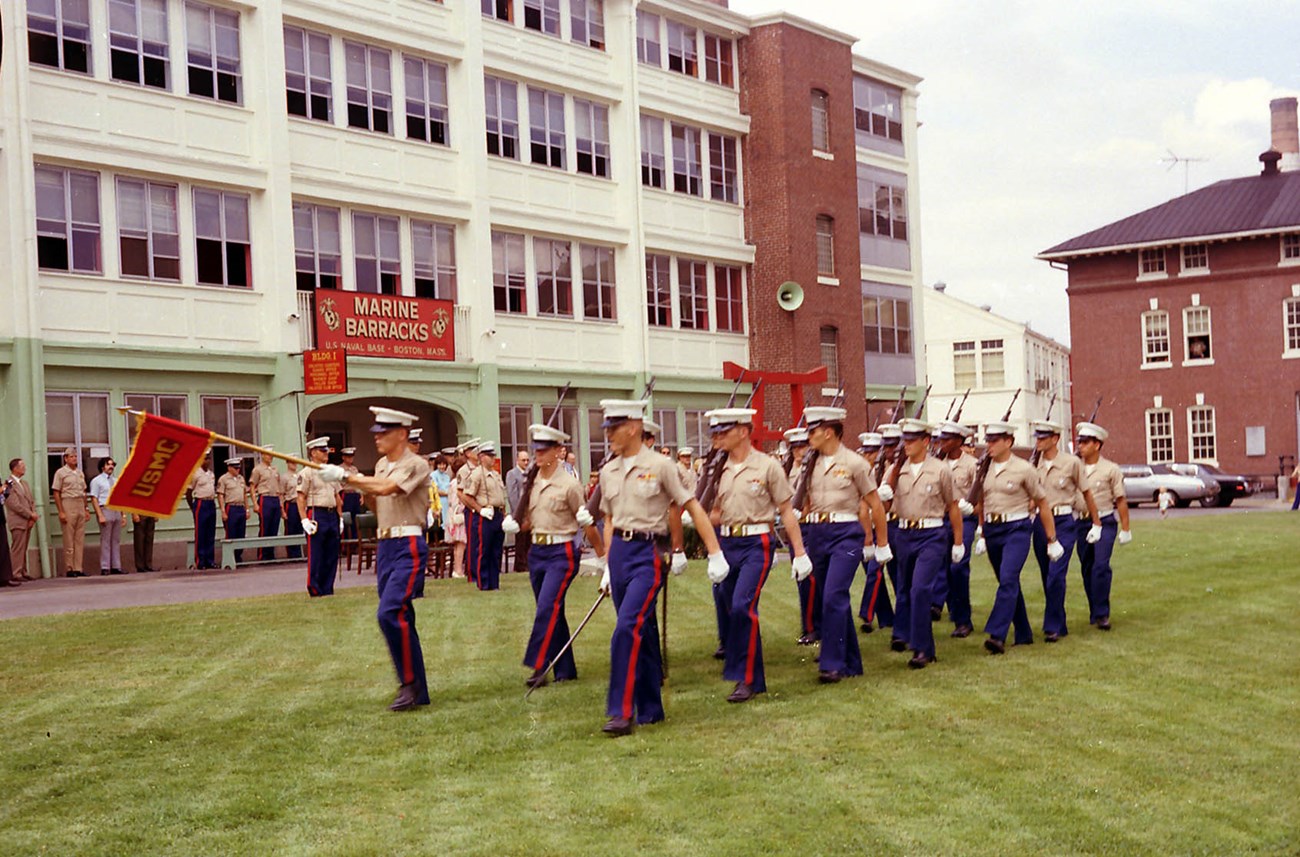
Boston National Historical Park, BOSTS 7637-15x.
The Marine Barracks in the Charlestown Navy Yard—Building I—is the second oldest building in the Yard and the oldest US Marine Corps barracks in the United States. For 163 years, the Marine Barracks served as the home of the "Leathernecks" who guarded this Navy Yard, served on ships entering and departing the Yard, and responded to deployment orders to locations near and far as America's premier "Force in Readiness."
The story of the Marines who lived and worked here exemplifies the story of the Marine Corps as a whole. Beginning as a small, untested security force, the Marine Corps grew into a world-renowned military organization over the next two centuries. The Marine Barracks stands as a permanent reminder in the Navy Yard of their years of service here.
After the establishment of navy yards in 1800, the Secretary of the Navy directed the Marines to guard these new establishments. US Marines were present in Boston as early as 1799—a year after the establishment of the US Marine Corps (the earlier Continental Marine Corps was established in 1775 but then disbanded at the end of the American Revolutionary War). In May 1802, both the Secretary of the Navy and the Commandant of the Marine Corps authorized a 15-man Marine detachment for the Charlestown Navy Yard.
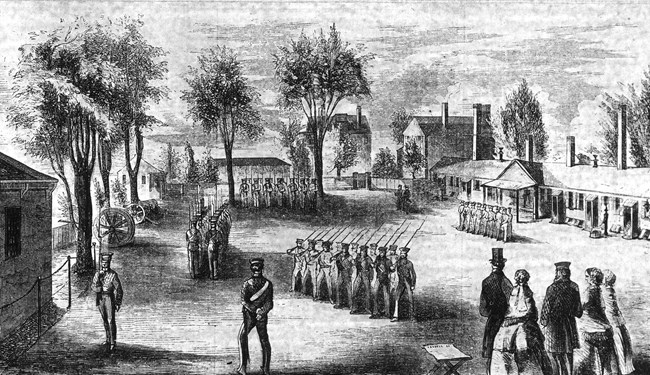
Boston Public Library, originally printed in Ballou's Pictorial, August 8, 1856, volume 11, issue 7, page 104.
Seeking a Permanent Home
Initially, the Yard's Marine detachment was temporarily quartered aboard USS Constitution. Their first commanding officer, Lieutenant Henry Caldwell, struggled to find a permanent barracks for his detachment of 19 enlisted Marines. Whereas tents sufficed in the summer, the harsh Boston winters required the Marines to shelter in an old lime shed. These austere living conditions hampered recruitment efforts.
Eventually, the Secretary of the Navy approved $5,000 for the construction of a barracks building. However, the barracks had to be built from material not in use already by the Navy. The Marines themselves began constructing the Barracks in 1810 and completed the work in February 1811. The barracks could house up to 100 Marines. The original layout consisted of a central single-story building flanked by two three-story towers. The right-side tower served as quarters for the detachment commander, while junior officers lived in the left tower. Enlisted Marines ate, slept, and socialized in the one-story center section of the barracks. With a permanent home, they could expand their presence and their duties.
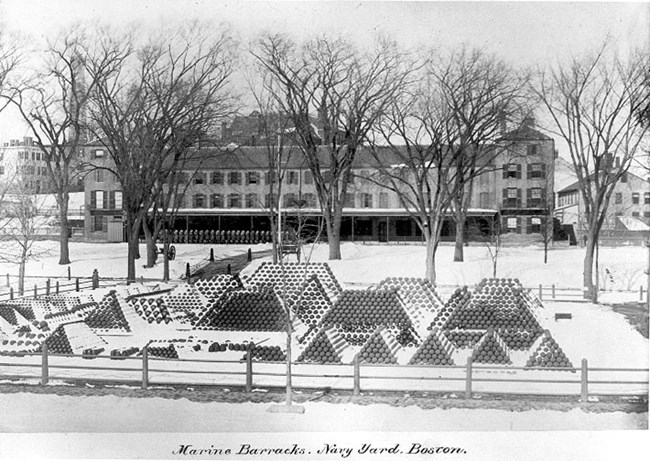
Boston National Historical Park, BOSTS 9219-1.
Expansion and Leadership
As the number of Marines grew at the Yard, so did the barracks. Major renovations coincided with wartime military expansion: 1861-1862 (Civil War) and 1898-1902 (the Spanish-American War and the Philippine-American War), which eventually resulted in the present-day four-story structure. During the 1930s and World War II in the 1940s, the Works Progress Administration also improved the barracks. By World War II, the Marine detachment numbered 19 officers and 624 enlisted Marines, its largest size yet.
Due to this expansion, the barracks eventually contained wells, a post exchange, barber shop, brig (jail), tailor, laundry room, recreation space, pistol range, galley (kitchen), internal plumbing, bathrooms, bunking, and social clubs. More than a place to live, it was an enclosed community unto itself.
Hundreds of men walked through the halls of the Marine Barracks. Some have left a legacy that survives today, both on the Navy Yard and the Marine Corps as a whole. Between 1802 and 1974, 146 men served as the commanding officer for the Marine detachment here, ranging in rank from sergeant to lieutenant colonel. Two of the detachment's commanding officers later served as Commandant of the Marine Corps: Colonel Archibald Henderson and Colonel Charles McCawley. They served at the Navy Yard during periods of change, and continued to help shape the Marine Corps as Commandants.

Courtesy Boston Public Library, Leslie Jones Collection
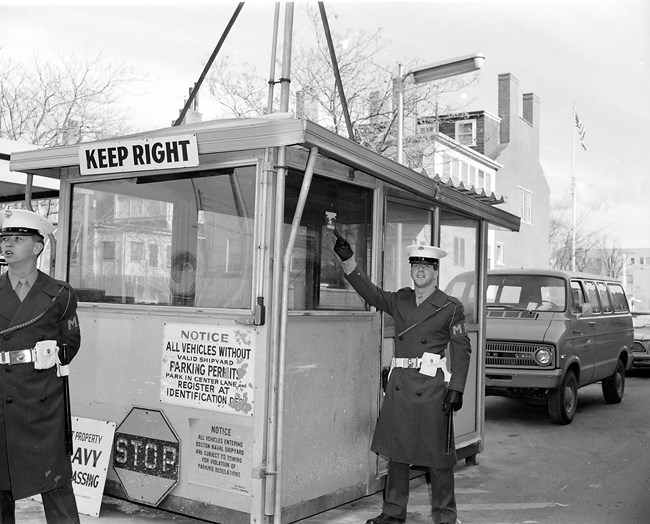
Boston National Historical Park, BOSTS 8956-9826.
Duties and Drill
The most visible duty of the Marines was at the entrances to the yard. Workers, sailors, and visitors all had to pass a Marine guard whenever entering and exiting. By the 1900s, Marines guarded the main entrance to the Yard—Gate 1—24-hours a day, checking workers' identification badges, inspecting deliveries, and guarding against sabotage.
The large grassy area in front of the barracks served as the Marines' parade ground. Within months of completing the Marine Barracks in 1811, the detachment received orders to create a parade ground for inspections, ceremonies, exercises, and drills. During the 1800s until 1974, field and naval cannons have been displayed on the grounds. Some of these cannons date back to the Mexican-American War. Today, only their pedestals can be seen. However, the red Japanese Torii Gate, added in 1963, is still present in front of the barracks. A Torii Gate, associated with Shintoism, symbolizes the transition from the mundane to the sacred, and has been long used by the US Military to represent service in East Asia. Workout equipment, including a rope hang, were installed in the 1960s and are still used by the Charlestown community today.
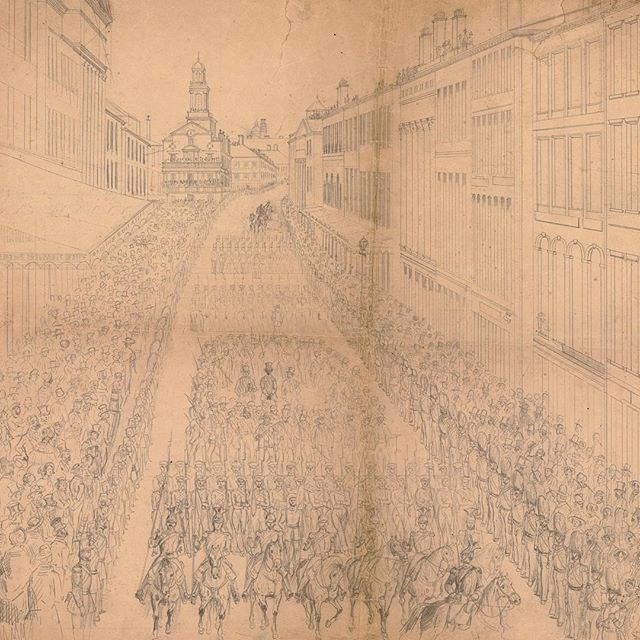
American Antiquarian Society
The Marines in Boston
By being the armed guards of the largest federal installation in Greater Boston, the Marines in Charlestown were often called upon to perform duties beyond the Navy Yard. The Marines regularly joined parades and ceremonies, but also in certain emergencies served as an extension of law enforcement.
In 1824, Marines reported to the Charlestown State Prison to quell a prisoner takeover of the dining hall. They successfully dispersed the prisoners without firing. A decade later, anti-Catholic mobs destroyed the Ursuline Convent in Somerville. Marines guarded those arrested to prevent like-minded rioters from freeing them. In 1854, US Marshals called upon the Marines to aid in the forceful return of freedom seeker Anthony Burns to slavery. Following a failed attempt to break Burns out of federal custody, President Franklin Pierce authorized all federal resources to return Burns to slavery. The Marines from Charlestown formed part of the 1,500 man guard.
Marines further prevented rioting and looting in the aftermath of the Great Boston Fire of 1872 and the Great Chelsea Fire of 1908. In 1972, Marines also removed anti-war protestors who briefly occupied the captain's quarters of USS Constitution.
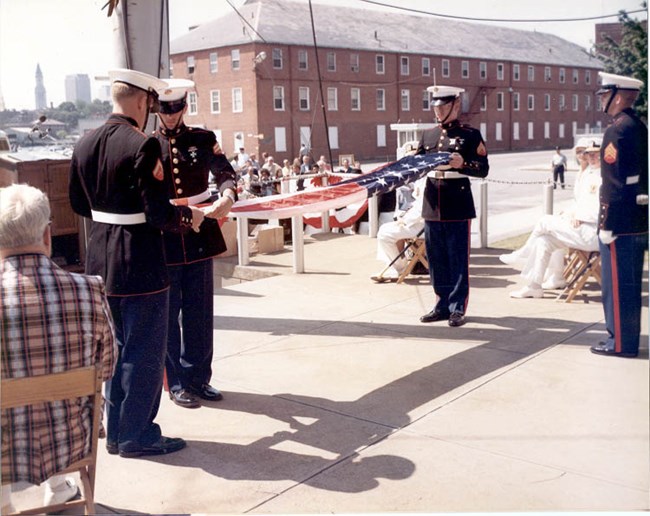
Boston National Historical Park, BOSTS 7617-11
Closure of the Yard
With the closure of the Charlestown Navy Yard in 1974, the era of a permanent Marine presence at the yard came to an end. The detachment commander, Lieutenant Colonel John R. Yates Jr., reflected on this closure: "[I] merely expected to be one in a continuous line of Barracks commanders. [I] didn’t expect to be the last."
The Marine Barracks closed on May 1, 1974. On July 1, 1974, the remaining Marines undertook their final official act at the Charlestown Navy Yard by lowering the US Flag at the Yard's closure ceremony.
Today, the Marine Barracks continues its service by housing the current stewards of the yard—the National Park Service. Used as office space and living quarters for park staff, the barracks remain vital to the operation of the yard. Looking out over USS Constitution and Boston Harbor, the barracks exemplify the motto that guides the Marine Corps to this day: Semper Fidelis—"Always Faithful."
Sources
Bearss, Edwin C. Historic Resource Study: Charlestown Navy Yard, 1800-1842, Volume II. Boston, Massachusetts: Boston National Historical Park, National Park Service, U.S. Department of the Interior, October, 1984.
Black, Frederick R.. Charlestown Navy Yard: 1890-1973, Volume I and Volume II. Boston, Massachusetts: Division of Cultural Resources, Boston National Historical Park, National Park Service, U.S. Department of the Interior, 1988.
Carlson, Stephen P. Charlestown Navy Yard Historic Resource Study, Vol 1-3. Boston, MA: Division of Cultural Resources Boston National Historical Park National Park Service U.S. Department of the Interior, 2010.
Yates, Lt. Col. John R. and Thomas, The Boston Marine Barracks: A History, 1799 - 1974, North Carolina, McFarland & Company Inc., 2015.
